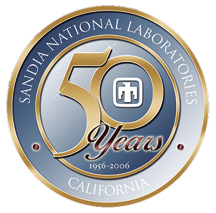Sandia/California’s 50 years of accomplishments were feted in three days of celebration last week, including a rededication ceremony in which Mim John, VP of the California Laboratory, looked to the past and future and welcomed back pioneering employees and four former vice presidents of the site.

“Our work has been shaped by our engineering and science missions and the events of the world,” Mim noted, saying she felt both proud and humbled. The site was officially established March 8, 1956, to provide engineering oversight for nuclear weapons whose explosive “physics packages” were being developed across the street at what is now Lawrence Livermore National Laboratory (LLNL).
From a couple of dozen employees who initially worked in a former Navy barracks, the site grew by the 1960s to a workforce that has stayed at about 1,100. Programs branched from strictly defense to include energy, bioscience, and microfluidics. Sponsors expanded to include the Department of Homeland Security (DHS), and interactions spread to involve industry, academia, and the state and region.
Labs President and Director Tom Hunter, himself a former California site VP, was the first to speak at Wednesday’s rededication ceremony. He said the world has changed remarkably in the last five decades but he is convinced “the nuclear deterrent will capture and maintain an enduring peace that can contribute to a more confident and secure world. . . . I think we can set the stage for looking at security in a whole new way.”
Mel Bernstein, who had just been named the previous week as acting director of the DHS Office of Research and Development (and was once offered work at Sandia/California), acknowledged that transformation and promise by observing the California laboratory has “an incredible gift — the ability to adapt and to be flexible.”
At the close of the event, retired Sandia Executive VP John Crawford, who also was a vice president of the California site, noted that the site’s talented staff enjoys access to well-equipped facilities and responds with agility to opportunities, expertly melding science and engineering.
‘Pound for pound you’re the best’
Keynote speaker Johnny Foster, retired director of LLNL, also lauded that uniqueness, saying, “Pound for pound, you’ve outperformed the other labs.”
He recalled the question posed to him by the director of Los Alamos National Laboratory in 1962: whether LLNL should concentrate on nuclear work and LANL should focus on science? He responded after a moment that he believed both should continue competing and cooperating.
Foster said he still believes competition is critical for technological leadership in the face of new potential adversaries.
As nuclear weapons age and are retired from the stockpile, he said, the deterrent threat must still be viewed as credible. There are less than one-tenth the number of active warheads and warhead types in the current stockpile than during the Cold War. With approval of the Reliable Replacement Warhead (RRW) program, new components and features may be introduced, but the possibility that unknown failure modes would be introduced requires a higher standard of reliability, Foster said.
He offered four suggestions:
• Create an improved process for learning from past failure modes and competitively develop a new learning process.
• Apply the new process to the design and production of refurbished weapons and the RRW.
• Provide additional assurance of reaching targets by using two different warhead types for each weapon system.
• Introduce an incentive reward system for Red and Blue teams during the annual certification of the stockpile.
He said ensuring the stockpile is safe, secure, reliable, and credible is so important that Sandia’s California and New Mexico laboratories should compete in addition to LANL and LLNL and directors of all four laboratories should be called upon when certifying the stockpile.
“This is a first-class lab in a beautiful setting,” Foster concluded. “I give great credit, particularly to all the folks who have worked here over the years.”
Gayle Cain, one of the 82 Sandians who worked at the California site in 1956, marveled at the tremendous growth. He said the city had 6,000 residents and he had to wait two months for a house to go on the market, buying one of the two that went up for sale. Also present at the ceremony were Sandia pioneers Frank Murar and Pat Gildea, as well as about 900 employees or retirees and guests.
The audience heard remarks from LLNL’s Bruce Goodwin, associate director for Defense and Nuclear Technologies; Jerry Paul, principal deputy administrator of the National Nuclear Security Administration; Jim Decker, principal deputy director of the DOE Office of Science; and Garry George, head of the Engineering and Systems Division of the United Kingdom’s Atomic Weapons Establishment.
Forming a vision for the future
Former California Laboratory VP Tom Cook commented that he was particularly proud the slate of speakers made so much mention of the role of science. His successor to head the site, retiree Dick Claassen, said he was gratified by the interaction with all the outside groups (for instance, the Alameda County Board of Supervisors had a proclamation presented at the event).
“It was a time to look back at both the people and the challenges that frame this laboratory,” commented Tom Hunter, who was vice president of the site just prior to Mim. “Now it’s really important to take those and form the vision for the future. We see Sandia/California as an important part of that. The strong relationship with Lawrence Livermore was recognized by all the speakers. It’s deeper than the mission in how people engage each other; there is camaraderie as they collaborate and compete.”
Added John Crawford, “So many organizations recognized the value of this laboratory over a long period of years, it confirms they are adding a lot of value. Hopefully these kinds of comments will make people understand their work is appreciated.”